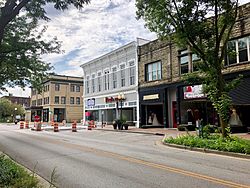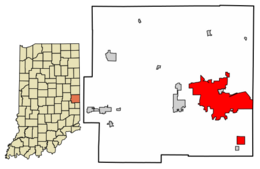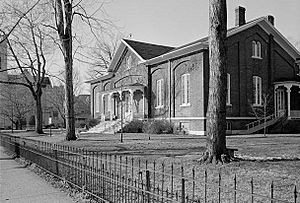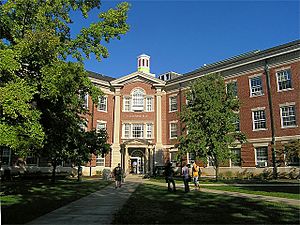Richmond, Indiana facts for kids
Quick facts for kids
Richmond, Indiana
|
|||
|---|---|---|---|

Richmond Downtown Historic District
|
|||
|
|||
| Nickname(s):
City of Roses
|
|||

Location of Richmond in Wayne County, Indiana.
|
|||
| Country | United States | ||
| State | Indiana | ||
| County | Wayne | ||
| Township | Boston, Center, Wayne | ||
| Area | |||
| • Total | 24.16 sq mi (62.56 km2) | ||
| • Land | 24.00 sq mi (62.17 km2) | ||
| • Water | 0.15 sq mi (0.39 km2) | ||
| Elevation | 978 ft (298 m) | ||
| Population
(2020)
|
|||
| • Total | 35,720 | ||
| • Density | 1,488.02/sq mi (574.54/km2) | ||
| Time zone | UTC−5 (EST) | ||
| • Summer (DST) | UTC−4 (EDT) | ||
| ZIP codes |
47374-47375
|
||
| Area code(s) | 765 | ||
| FIPS code | 18-64260 | ||
| GNIS feature ID | 2396366 | ||
Richmond is a city in eastern Wayne County, Indiana, United States. It is right next to the state of Ohio. Richmond is the main city of the county and the largest city in the Richmond micropolitan area. In 2020, about 35,720 people lived there.
Richmond is sometimes called the "cradle of recorded jazz." This is because the very first jazz recordings were made there. They were recorded at the Gennett Records studio. Famous artists like Louis Armstrong and Jelly Roll Morton recorded their music in Richmond. The city has won the All-America City Award twice, most recently in 2009.
Contents
History
Early Settlers and Quaker Roots
In 1806, the first European American families moved to this area. They were Quakers from North Carolina. They settled along the East Fork of the Whitewater River. This was part of a big move westward after the American Revolution. John Smith and David Hoover were some of the first people to settle here. Richmond still has several Quaker places, like Friends United Meeting and Earlham College.
The settlement officially became a town on September 1, 1818. At that time, it had only 24 adult settlers. The first post office in Richmond opened in 1818.
Richmond's Role in Early Cinema
Charles Francis Jenkins, a pioneer in early movies and television, grew up near Richmond. He started inventing useful devices there. On June 6, 1894, Jenkins showed a filmed motion picture to an audience for the first time. This happened at his cousin's jewelry store in downtown Richmond. The movie showed a vaudeville dancer.
Jenkins later got a patent for his projector, called the Phantoscope. A changed version of his projector was sold to Thomas Edison. Edison called it Edison's Vitascope. This helped start American cinema in New York City.
Music and Arts in Richmond
Richmond is thought to be the smallest community in the U.S. that had its own professional opera company and symphony orchestra. The Whitewater Opera has since closed. However, the Richmond Symphony Orchestra is still active. In 1899, Will Earhart started the first full high school orchestra in the country.
Many famous musicians recorded in Richmond. Hoagy Carmichael recorded his famous song "Stardust" for the first time at the Gennett recording studio. The legendary trumpeter and singer Louis Armstrong also made his first recordings at Gennett. He was part of King Oliver and his Creole Jazz Band.
A group of artists in the late 1800s and early 1900s became known as the Richmond Group. They included artists like John Elwood Bundy and Charles Conner. The Richmond Art Museum has a collection of art from this area.
Transportation and Unique Features
Richmond was connected to the National Road. This was the first road built by the U.S. government. It was a major route for pioneers moving west in the 1800s. Today, this highway is known as U.S. Route 40. A special monument called the Madonna of the Trail was placed in Richmond in 1928. It sits in Glen Miller Park, next to US 40.
Richmond is also known for its unique historical items. It has two of Indiana's three Egyptian mummies. One is at the Wayne County Historical Museum. The other is at Earlham College's Joseph Moore Museum. This has given Richmond the nickname "Mummy capital of Indiana."
Manufacturing and Industry
Richmond once had a strong economy based on making things. It was known as "the lawn mower capital" because many lawn mowers were made there. Companies like Davis and Motomower built lawn mowers from the late 1800s to the mid-1900s. The farm machine builder Gaar-Scott was also based in Richmond.
The Wayne Agricultural Works, which made horse-drawn vehicles, moved to Richmond. They made "kid hacks," which were like early school buses. From the 1930s to the 1940s, several automobile designers and makers were in Richmond. Cars like the Richmond, Davis, and Westcott were made there.
In the 1950s, Wayne Works became Wayne Corporation. It was a well-known maker of buses and school buses. The company moved in 1967 and was a leader in making school buses safer. However, it closed in 1992.
Richmond was also called the "Rose City." This was because Hill's Roses grew many different kinds of roses there. The company had huge greenhouses, covering about 34 acres. The yearly Richmond Rose Festival celebrated the rose industry.
Geography
Richmond is located at 39.830189 degrees North latitude and -84.890668 degrees West longitude.
According to the 2010 census, Richmond covers about 24.067 square miles (62.33 square kilometers). Most of this area, about 23.91 square miles (61.93 square kilometers), is land. A small part, about 0.157 square miles (0.41 square kilometers), is water.
Demographics
| Historical population | |||
|---|---|---|---|
| Census | Pop. | %± | |
| 1840 | 2,070 | — | |
| 1850 | 1,443 | −30.3% | |
| 1860 | 6,608 | 357.9% | |
| 1870 | 9,445 | 42.9% | |
| 1880 | 12,742 | 34.9% | |
| 1890 | 16,608 | 30.3% | |
| 1900 | 18,226 | 9.7% | |
| 1910 | 22,824 | 25.2% | |
| 1920 | 26,765 | 17.3% | |
| 1930 | 32,493 | 21.4% | |
| 1940 | 35,147 | 8.2% | |
| 1950 | 39,539 | 12.5% | |
| 1960 | 44,149 | 11.7% | |
| 1970 | 43,999 | −0.3% | |
| 1980 | 41,349 | −6.0% | |
| 1990 | 38,705 | −6.4% | |
| 2000 | 39,124 | 1.1% | |
| 2010 | 36,812 | −5.9% | |
| 2020 | 35,720 | −3.0% | |
| Source: US Census Bureau | |||
Population in 2010
In 2010, there were 36,812 people living in Richmond. There were 15,098 households and 8,909 families. The population density was about 1,539 people per square mile.
The average age in the city was 38.4 years old. About 22.1% of the people were under 18 years old. About 16.5% were 65 years or older. The city had slightly more females (52.1%) than males (47.9%).
Points of Interest
Richmond has many interesting places to visit:
- Hayes Arboretum
- Cope Environmental Center
- Wayne County Historical Museum
- Richmond Art Museum
- Indiana Football Hall of Fame
- Gaar Mansion (a house museum)
- Joseph Moore Museum at Earlham College
- Glen Miller Park and the Madonna of the Trail statue
- Richmond Downtown Historic District
- Old Richmond Historic District
- Starr Historic District
- Richmond Railroad Station Historic District
- Reeveston Place Historic District
- East Main Street-Glen Miller Park Historic District
- Don McBride Stadium (a baseball ballpark built in 1936)
- Reid Memorial Presbyterian Church (known for its Louis Comfort Tiffany-designed interior)
- Bethel AME Church (the oldest AME church in Indiana, founded in 1868)
- Old National Road Welcome Center
- Whitewater Gorge Park and Gennett Walk of Fame
- Cardinal Greenway (a hiking trail)
- Richmond Civic Theatre (offers plays, classic movies, and children's theater)
- Madonna of the Trail statue at Glen Miller Park
- Gennett Records Walk of Fame
- Richmond Mall, a shopping mall
Education
Richmond is home to four colleges:
- Earlham College
- Indiana University East
- Ivy Tech Community College of Indiana
- Purdue Polytechnic Institute – Richmond
It also has two seminaries (schools for religious studies):
- The Quaker Earlham School of Religion
- The Church of the Brethren Bethany Theological Seminary
Richmond High School includes the Richmond Art Museum and the Civic Hall Performing Arts Center. Seton Catholic High School is a religious junior and senior high school.
The city also has a public library called the Morrisson Reeves Library.
Religious Groups
Richmond is the main office for Friends United Meeting. It also hosts the Quaker Hill Conference Center for the Religious Society of Friends (Quakers).
Media
The daily newspaper in Richmond is the Palladium-Item.
You can listen to several full-power radio stations, including WKBV, WFMG, WQLK, WKRT, and Earlham College's student radio station WECI.
Transportation
Richmond Municipal Airport is an airport located about 6 miles (9 km) southeast of downtown Richmond. It is owned by the Richmond Board of Aviation Commissioners. The closest airport with commercial flights is Dayton International Airport.
Interstate 70 serves Richmond with several exits.
Richmond's Pennsylvania Railroad station was a busy hub for trains in the past. It was used by Pennsylvania Railroad and later Penn Central trains until the late 1960s. The last passenger train, the National Limited, stopped service in 1979.
Public transportation is provided by Roseview Transit. It operates daily except on Sundays and major holidays.
Notable People
Academics
- Landrum Bolling: President of Earlham College, known for humanitarian work.
- Mary Haas: A linguist and professor at University of California-Berkeley.
- Wendell Stanley: A biochemist and virologist who won a Nobel Prize.
Actors
- Timothy Brown: A professional football player and actor.
- Norman Foster: An actor and director.
- Sarah Purcell: An actress.
Artists and Designers
- George Herbert Baker: An Impressionist painter.
- John Elwood Bundy: An Impressionist painter.
- Charles Fremont Conner: An Impressionist painter.
- Gaar Williams: A cartoonist.
Business Leaders
- Charles Francis Jenkins: A pioneer in early movies and one of the inventors of television.
- Daniel G. Reid: An industrialist and philanthropist.
Musicians
- May Aufderheide: A ragtime composer.
- George Duning: A musician and composer.
- Baby Huey: A rock and soul singer.
- Jeff Hamilton: A jazz drummer.
- Rich Mullins: A singer and musician.
- Sondra Radvanovsky: An opera singer.
- Ned Rorem: A composer who won a Pulitzer Prize.
Politicians and Civic Leaders
- Thomas W. Bennett: Richmond mayor and Governor of Idaho territory.
- Levi Coffin: An organizer of the Underground Railroad.
- David W. Dennis: A U.S. Congressman.
- Oliver P. Morton: Indiana's governor during the Civil War.
Scientists
- Charles A. Hufnagel: An M.D. who invented the artificial heart valve.
- Wright brothers: Famous aviation pioneers.
Sports Figures
- Desmond Bane: An NBA player for the Memphis Grizzlies.
- Weeb Ewbank: A coach who won the NFL championship and the Super Bowl III.
- Vagas Ferguson: An NFL running back.
- Paul Flatley: An NFL wide receiver.
- Del Harris: A professional basketball coach.
- Daniel Kinsey: A hurdler who won an Olympic gold medal.
- Lamar Lundy: A football player, part of the L.A. Rams' "Fearsome Foursome."
- Bo Van Pelt: A professional golfer.
Writers and Journalists
- Christopher Benfey: A literary critic.
- William Dudley Foulke: A lawyer and author.
Sister Cities
Richmond has two sister cities:
 Serpukhov, Russia
Serpukhov, Russia Unnan, Shimane Prefecture, Japan
Unnan, Shimane Prefecture, Japan
See also
 In Spanish: Richmond (Indiana) para niños
In Spanish: Richmond (Indiana) para niños






